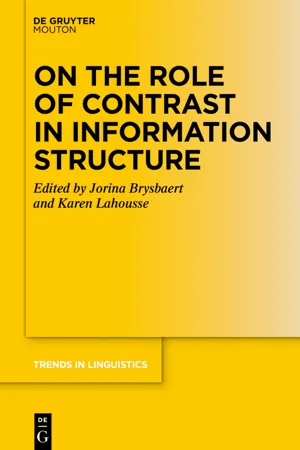
- 270 pages
- English
- ePUB (mobile friendly)
- Available on iOS & Android
On the Role of Contrast in Information Structure
About this book
In research on Information Structure, there is an ongoing discussion about the role of contrast.
While most linguists consider contrast to be compatible with both focus and topic, some argue that it is an autonomous IS category. Contrast has been shown to be encoded by different linguistic means, such as specific morphemes, adverbials, clefts, prosodic cues. Hence, this concept is also related to other domains, in particular morphosyntax and prosody. The precise way in which they interact is however not yet entirely clear. Moreover, from a methodological point of view, the identification and annotation of contrast in corpora is not straightforward.
This volume provides a selection of articles discussing the definition of contrast, the importance of distinguishing different types of contrast, the use of several encoding strategies, and the annotation of contrast in corpora using the Question Under Discussion Model. The contributions offer data on English, French, French Belgian Sign Language, German, Hindi, Italian and Spanish.
Frequently asked questions
- Essential is ideal for learners and professionals who enjoy exploring a wide range of subjects. Access the Essential Library with 800,000+ trusted titles and best-sellers across business, personal growth, and the humanities. Includes unlimited reading time and Standard Read Aloud voice.
- Complete: Perfect for advanced learners and researchers needing full, unrestricted access. Unlock 1.4M+ books across hundreds of subjects, including academic and specialized titles. The Complete Plan also includes advanced features like Premium Read Aloud and Research Assistant.
Please note we cannot support devices running on iOS 13 and Android 7 or earlier. Learn more about using the app.
Information
Table of contents
- Title Page
- Copyright
- Contents
- 1 The complex nature of contrast
- Part I: Contrast versus topic and focus
- Part II: Different types of contrast
- Part III: Analyzing contrast using the Question Under Discussion model
- Subject index